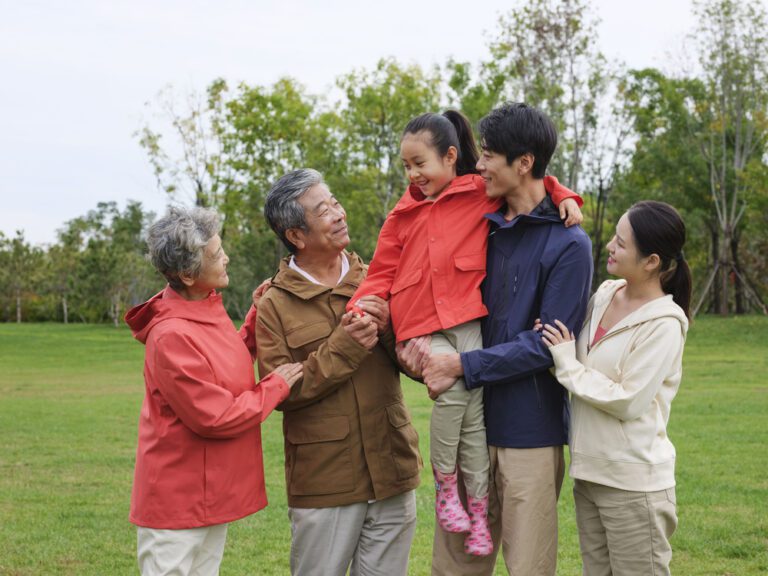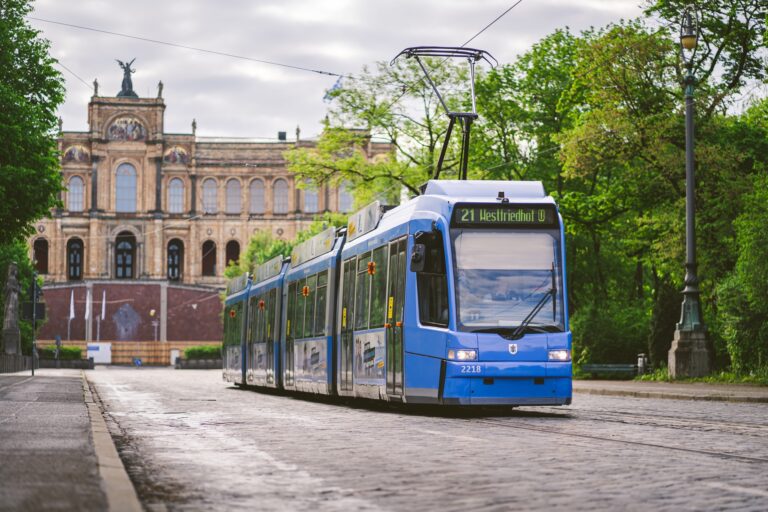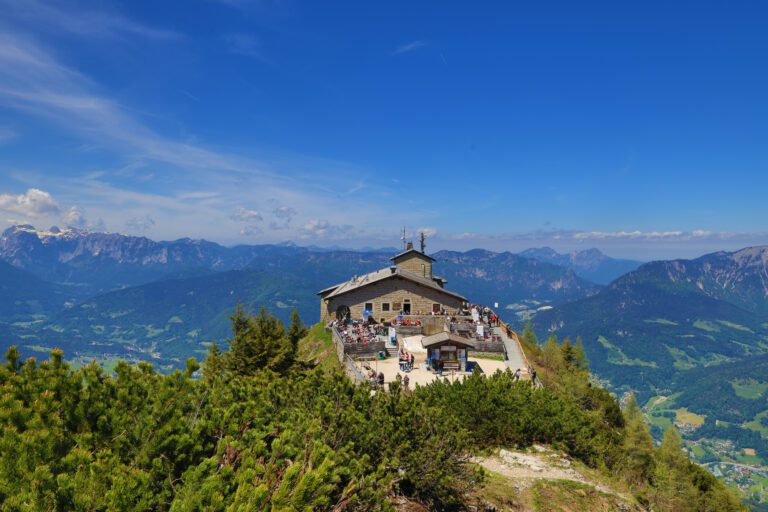Munich is a city where art, history, nature, culture, and tradition intertwine. Spending five days in Munich is a perfect time frame to delve deep into its many offerings, from world-class museums and historic sites to verdant parks and local beer culture. Five days also allow for a trip into the Bavarian Alps and the fairytale-like Neuschwanstein Castle.
As someone who has not only lived in Munich for several years but continues to explore the city regularly, I’ve gathered a wealth of knowledge and experiences. Munich is a unique city in Germany in its blend of deep-rooted traditions and a modern lifestyle. Here, the globally celebrated Oktoberfest is just a glimpse into the city’s beer culture. Beer is a lifestyle in its own right, and Bavarians wear Lederhosen and Dirndls with pride.
In addition, Munich is a very walkable city. You can visit all top attractions by foot or via a short ride on the excellent public transportation system.
I structured my recommendations by themes and geography and also attempted to sort them in an order of priority. Of course, every traveler has their priorities and preferences. So I included additional suggestions for activities at the end of the five-day itinerary as well as advice on how to get around in the city. If you are traveling with kids, please also check out my article: Munich with Kids: The Ultimate Guide.
Map: all sites mentioned in blog post are represented by points on the map. Zoom in and out to see more or less details. Click drop down menu on the top left to filter points by Day 1, Day 2, etc. Refresh the page to see all points again.
Day 1: Top Sights in Munich – Old Town and Hofbräuhaus
On your first day, explore Munich’s most famous sightseeing spots in the compact ‘Altstadt, or Old Town. These landmarks are conveniently close, allowing you to cover all of them on foot – I estimate it be approx. 2 miles.
Start at Marienplatz, the city’s central square, dominated by the “Neues Rathaus”(New Town Hall). Though it’s known as the ‘new’ town hall, its historical significance is undeniable, having been built between 1867 and 1909. Nearby, the older town hall, now the Spielzeugmuseum (Toy Museum), is a quaint but interesting visit if time allows.
For a panoramic view of Munich, consider the New Town Hall’s observation deck. It features an elevator, making it a more accessible alternative to St. Peter’s Church tower (see below). Tickets for the observation deck can be obtained at the tourist information located in the town hall, or they can be ordered online here.
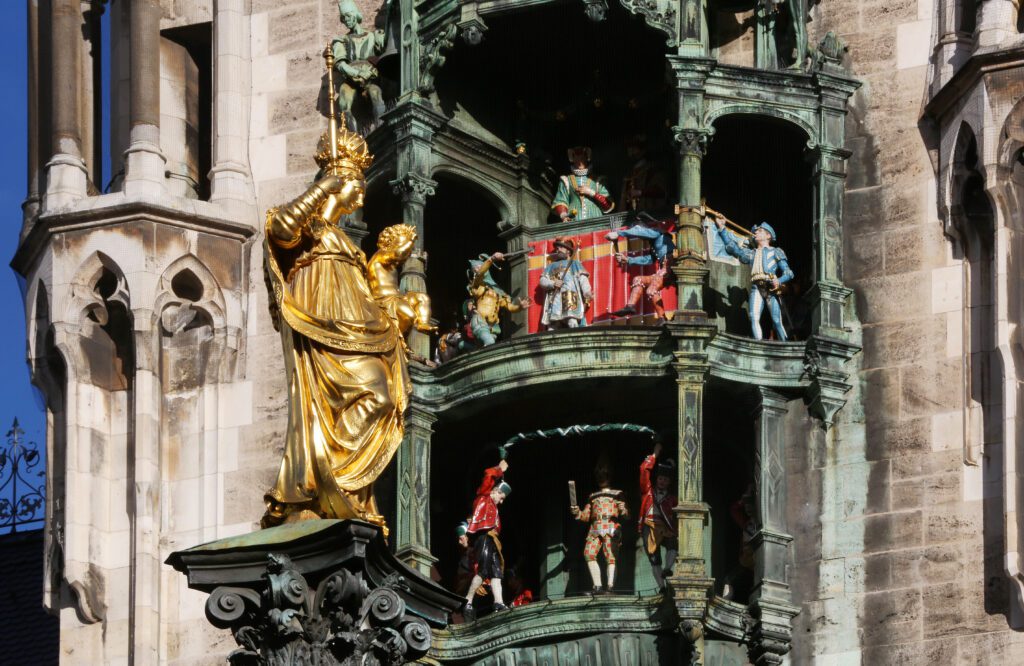
Additionally, the New Town Hall is renowned for its ‘Glockenspiel‘ in the clock tower, which comes alive with mechanical figures and bells at 11 am and 12 pm daily, and at 5 pm from March to October
Tip: For a bird’s eye view of the square and the Glockenspiel, head to Cafe Glockenspiel, Located on the fifth floor of the shopping center opposite of the New Town Hall, it offers a fantastic view of the Glockenspiel from one of their window tables.
At the other end of Marienplatz, St. Peter’s Church, the oldest in Munich, provides another vantage point. Be prepared for a step climb up a very narrow spiral stair case. If this seems daunting, the town hall’s observation deck (see above) is the more comfortable alternative.
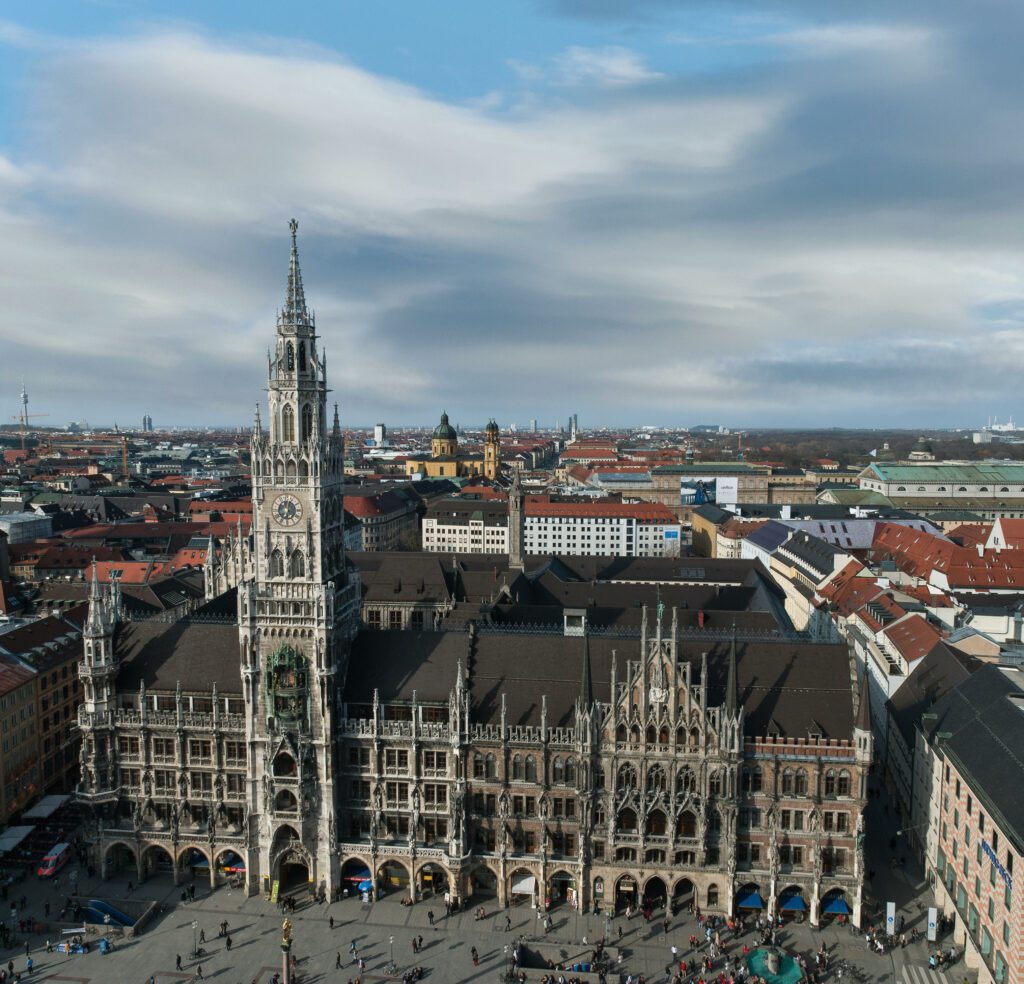
Next, make your way up the pedestrian zone to ‘Frauenkirche’, Munich’s gothic cathedral and most recognizable landmark. Its twin towers have been a defining feature of Munich’s skyline for centuries, so much so, that the city maintains a height limit on buildings to preserve this view. You are fee to walk around within the church (it’s customary to leave a Euro in the collection box on the way out).
For another impressive city view, the south tower’s observation deck offers a 360-degree panorama. There is a lift, but you’ll first need to climb a spiral staircase to the intermediate level. Tickets for the ascent can be booked in the passageway to the State Courtyard or in advance here.
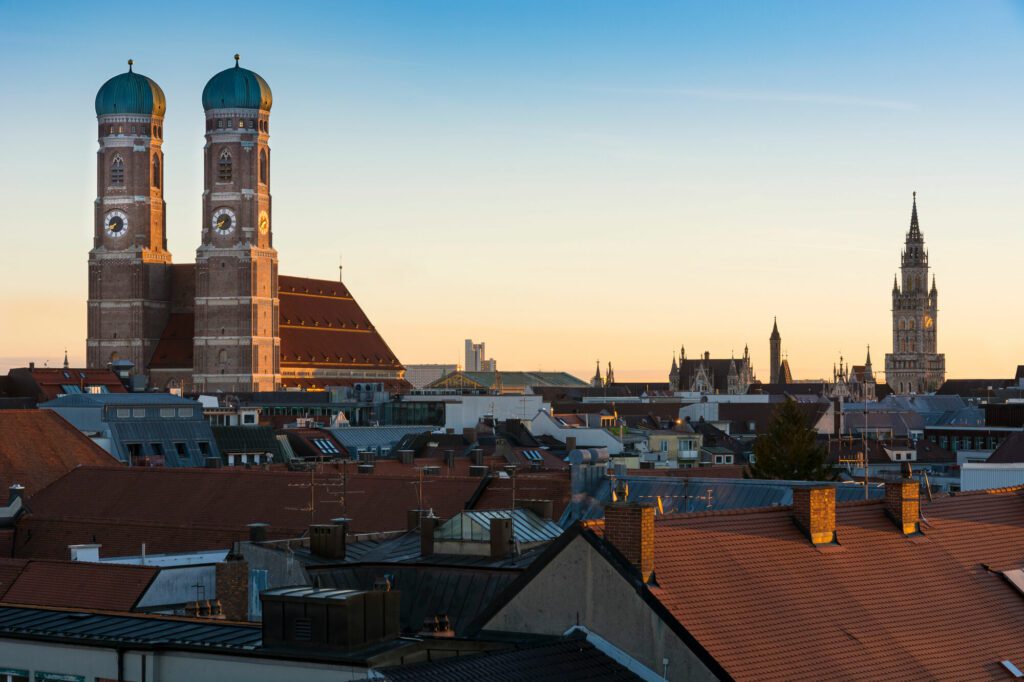
Retrace your steps to Marienplatz, and then continue south past the New Town Hall, where you’ll come across Viktualienmarkt. This part farmers market, part outdoor food market is an institution in Munich. Sample local delicacies, or take a break at the beer garden in the center of the market, where beers from six Munich breweries await. Look out for the traditional “Maibaum”.

A bit further south on Sendlinger Strasse lies ‘Asamkirche‘ (Adam church). This small but lavish church is nestled between other houses and might be easy to miss. Step inside to discover a baroque interior that is as ornate as it is awe-inspiring.
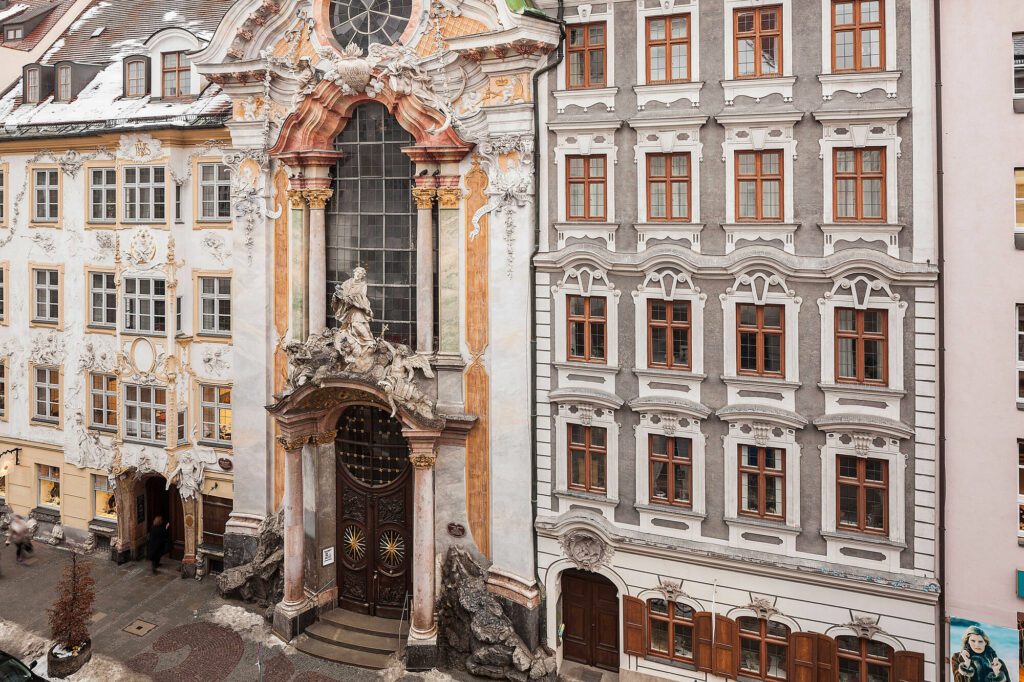
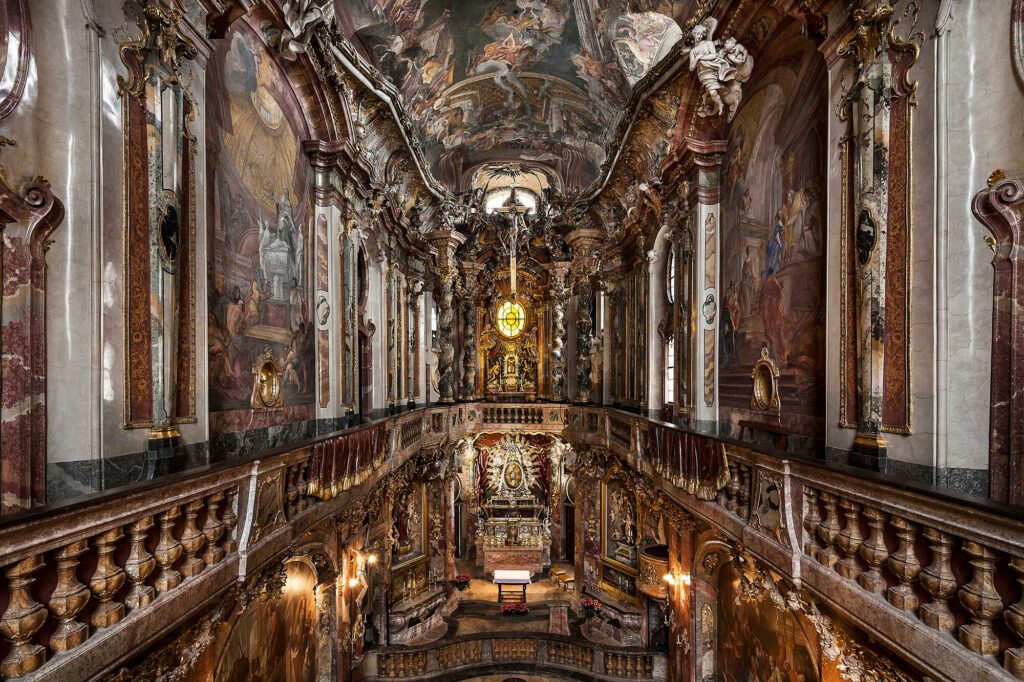
To complete your day exploring Munich’s traditional charm, head to the Hofbräuhaus. Established in 1607, this beer hall is not just the oldest in Munich, but a cornerstone of Bavarian beer culture. It’s a unique meeting ground where locals and visitors alike mingle, each adding to the lively atmosphere. Here, regulars have their personal ‘Krug’ (stein or mug) stored on a special shelf, symbolizing their connection to this iconic spot.
Inside, the classic beer hall setup with large square wooden tables and benches invites you to find a seat, perhaps even join others – it’s a wonderful opportunity to meet locals and fellow travelers. Hofbräuhaus beer is traditionally served in 1-liter steins, but you can get smaller portions. For a traditional meal, order ‘Schweinebraten’ (roast pork), generally served with potato dumplings and cabbage salad.
Alternatively, you could visit Hofbräuhaus on one of your mornings to enjoy a traditional Weisswurst (English: ‘white sausage’) breakfast. Weisswurst, a type of veal sausage, and served with sweet mustard and a pretzel, is traditionally enjoyed before 11 am. It’s a delightful way to immerse yourself in local customs.
Following your breakfast, you might opt for a guided tour of the brewery. It’s an insightful way to learn about the Hofbräuhaus’ storied history and its role in Munich’s cultural landscape.

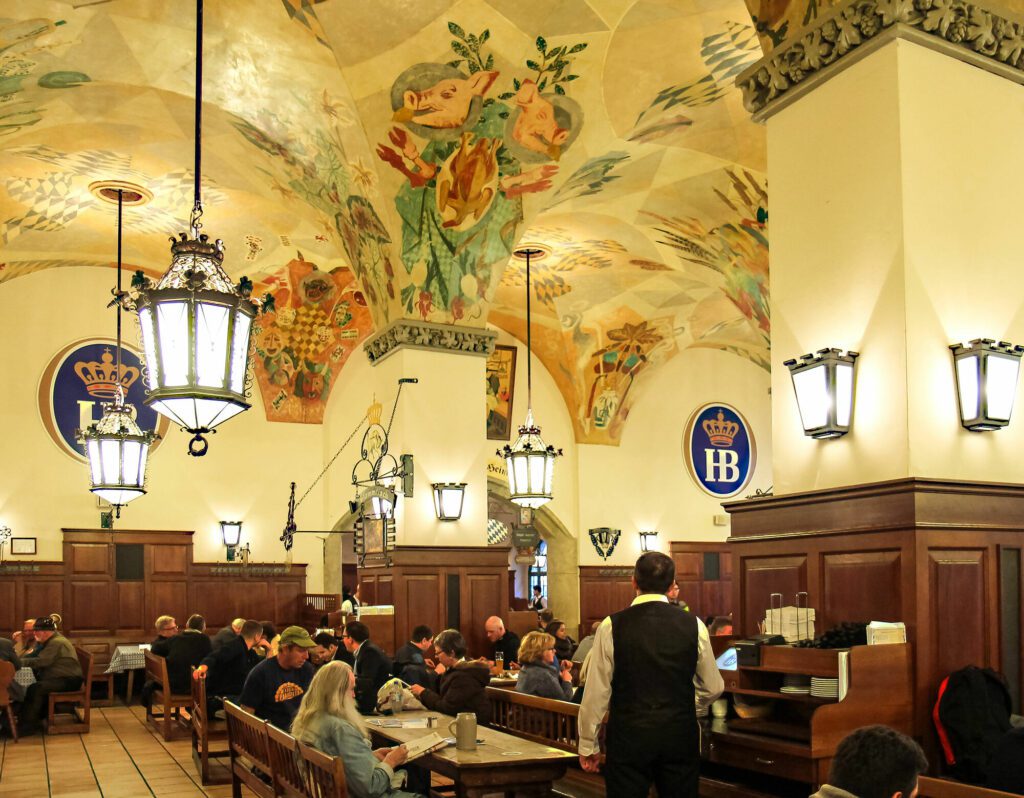


©München-Tourismus/G Standl
Day 2: Munich’s Dark History and Savoring the English Garden
For those with a keen interest in history, a Third Reich & WWII Walking Tour is an essential morning activity. The tour, starting at Koenigsplatz and ending at the university, takes you through significant historical sites from the National Socialist era. Start-and ending points of the tour are easily accessible by subway, providing a seamless start and end to your journey.
Note: If you’re planning to visit the English Garden afterward, then would do my suggested English Garden itinerary in reverse order, starting from the university and heading south towards Eisbachwelle.
Also, if you desire a deeper dive into Germany’s dark past, consider visiting the Dachau Concentration Camp Memorial. Outside of Munich, but accessible via public transport, this site preserves original buildings and offers a profound look into history. Plan for several hours, with audio guides or guided tours available for a comprehensive experience.
The English Garden is one of the biggest city parks in the world, larger than the Grand Central Park in New York. Residents of Munich love their park, strolling, picnicking, or floundering about in the stream that runs through it, a branch of the river Isar. Germans tend to have a very relaxed attitude about nakedness, so don’t be surprised to see sunbathers topless or in the nude.
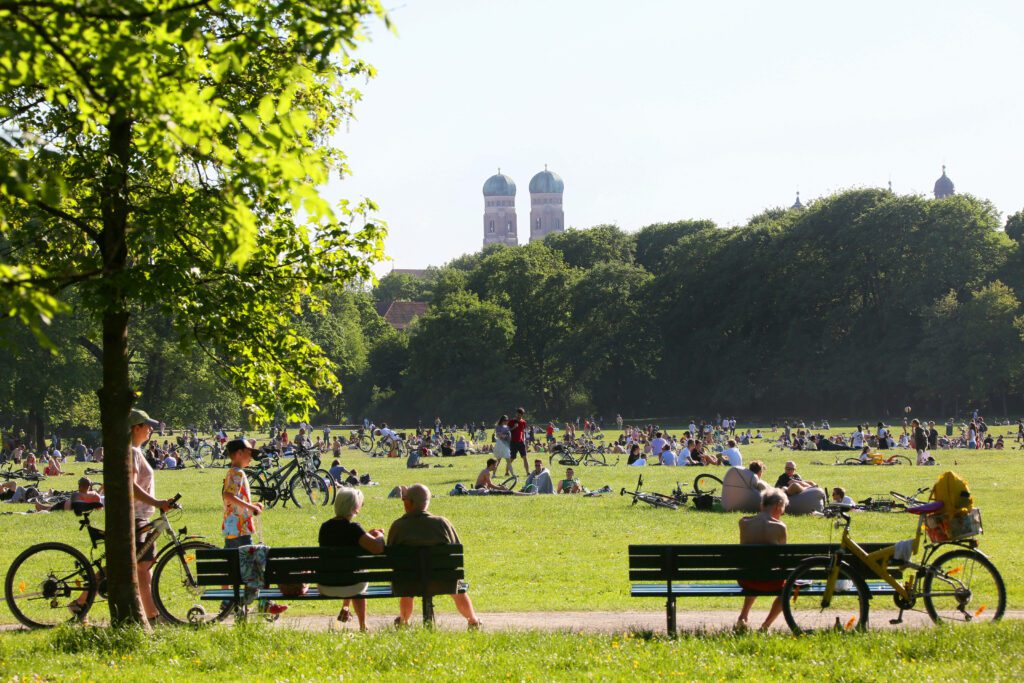
The itinerary through the English garden will be about two miles today by foot. Alternatively, you could do as the residents of Munich do and rent a bicycle. I recommend Mike’s Bikes, conveniently located in the old town and near the English Garden’s southern end.
Start at Eisbachwelle, the renowned man-made surfing wave on Prinzregentenstrasse, at the garden’s southern tip. It’s known for strong currents and thus is recommended for experienced surfers. The sight of surfers skillfully navigating this urban wave is a unique spectacle.
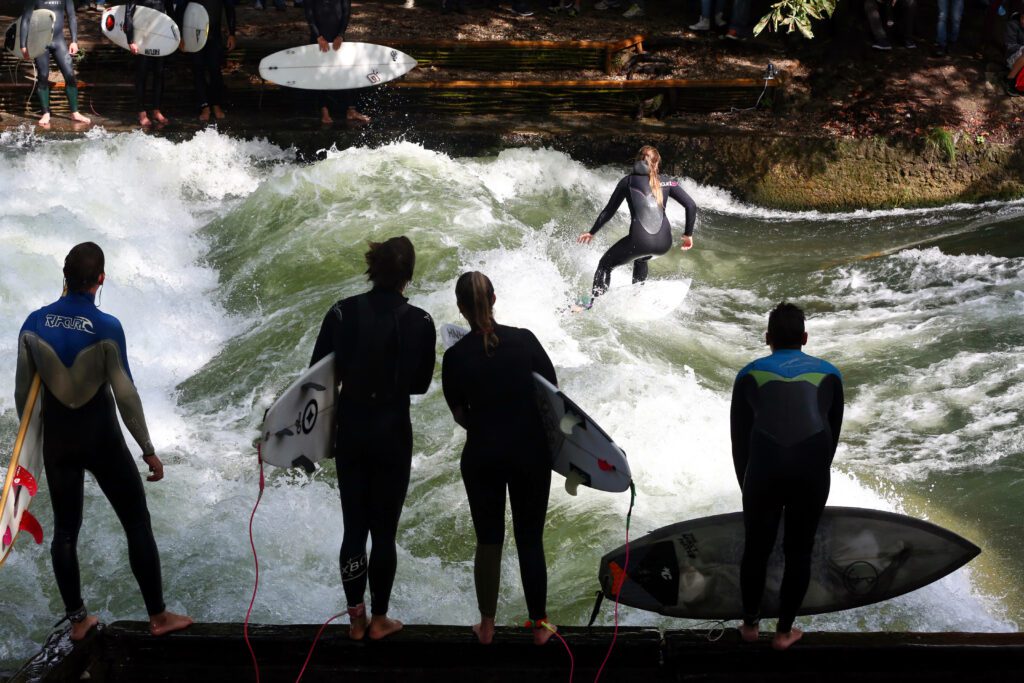
Next, head north to the Chinese Tower Beer Garden. Named after a 25-meter tall wooden pagoda, this beer garden is a hub of activity featuring a merry-go-round and, during winter, a Christmas market. Most of the time, there is also a brass band playing. With 700 seats, it’s breast Munich’s largest beer gardens, and it is serving Hofbräuhaus beer. Note that it opens at 11 am on weekdays and 10 am on weekends, and operates weather permitting.

Retrace your steps slightly to visit the Monopteros, a Greek-style temple offering panoramic city views. Exiting the English Garden on Veterinärstrasse, a short walk brings you to the prestigious Ludwigs-Maximilians-Universität (LMU), founded in 1472. The university’s main building, with its stunning atrium-style hall, is open to the public.
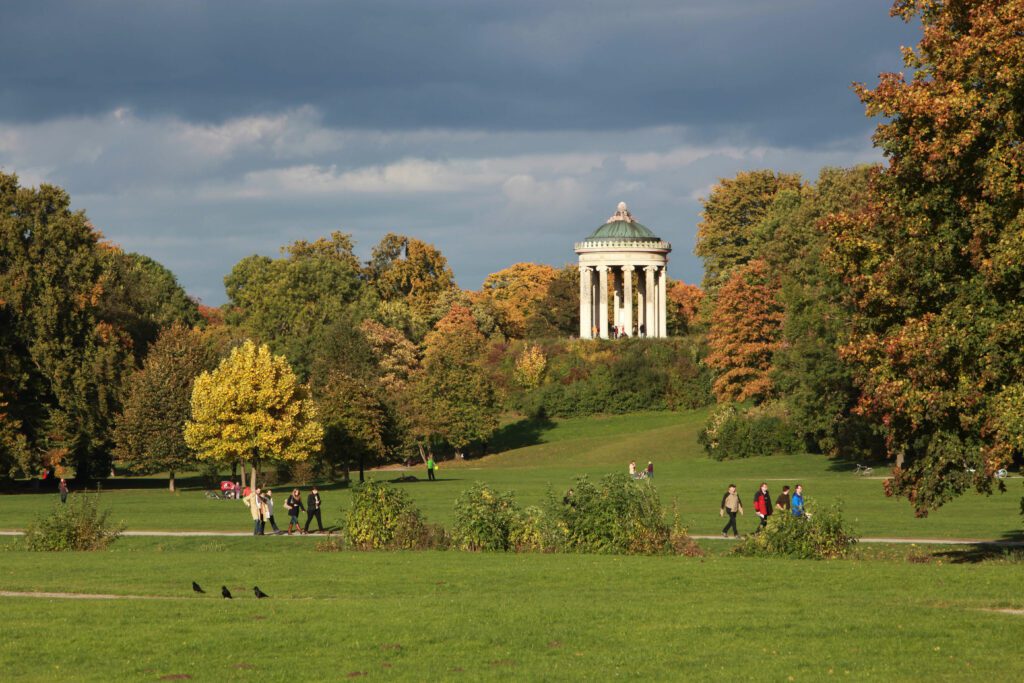
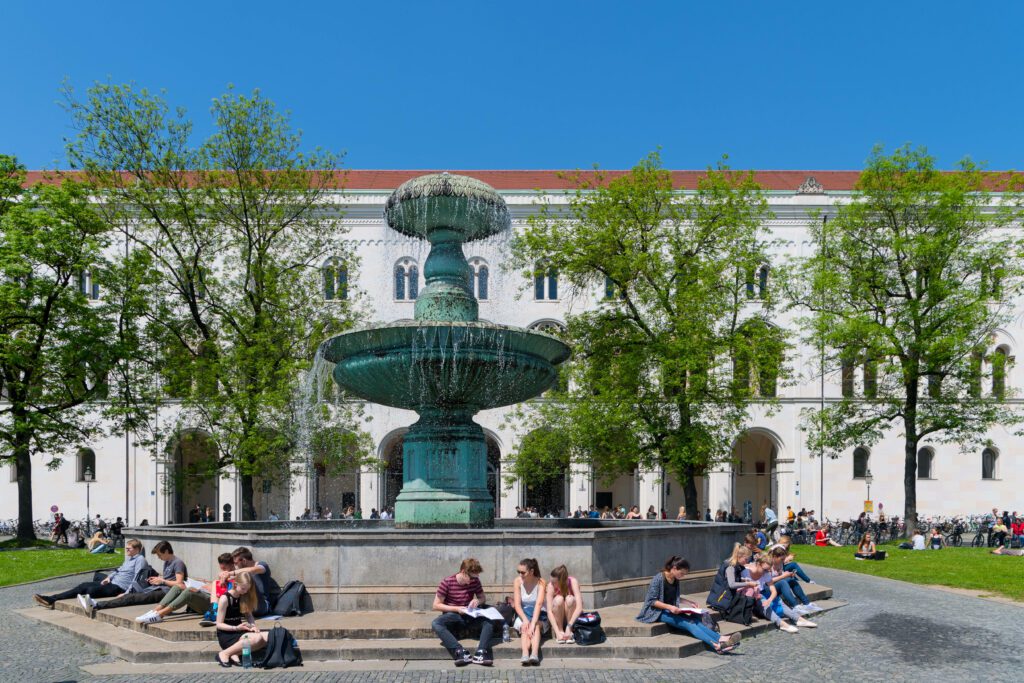
The university also played a significant role in WWII history as the base for The White Rose, a youth group opposing Hitler’s regime. Their courageous acts are commemorated at “Geschwister-Scholl-Platz” and in the cobblestone carvings in front of the university. A dedicated museum within the university delves deeper into their legacy.
Refresh and unwind at traditional Cafe Luitpold. This charming cafe has been a Munich institution since 1888. While well known for its pastries, cakes, and chocolates, it offers a full gourmet menu. You’ll reach the cafe by either walking about 15 minutes from ‘Geschwister-Scholl-Platz’ or by riding the subway one station to ‘Odeonsplatz’. If you’ve rented bikes, there’s a convenient rack outside. Cafe Luitpold.
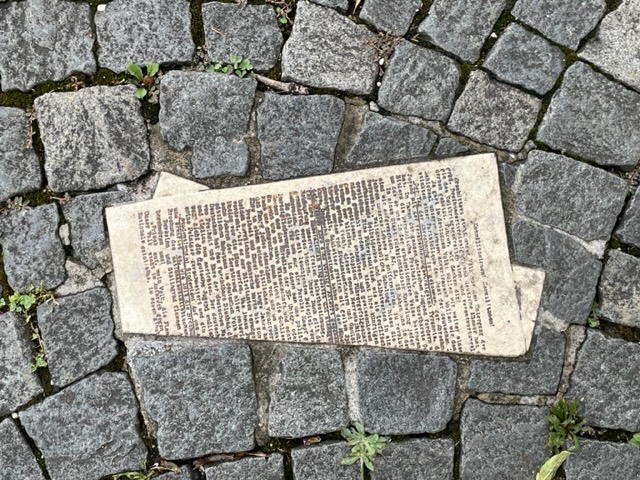

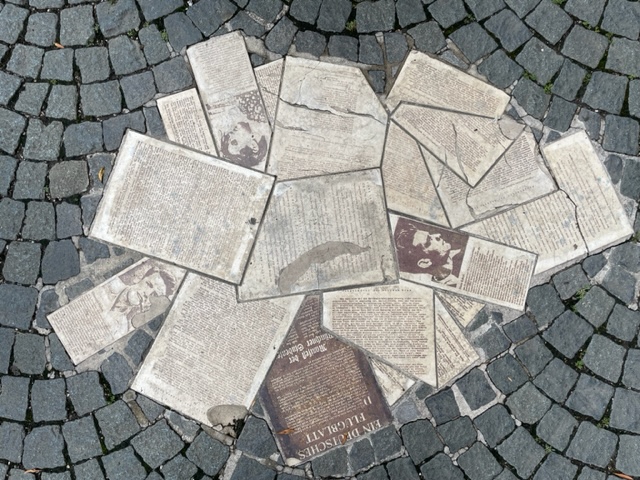
Day 3: Castles and Art in Munich
Munich proudly hosts two extraordinary castles: The Residenz, city palace at the northern border of the old town, and the Nymphenburg Castle, located about 15 minutes to the northeast. If time constraints only allow for one, I would recommend Nymphenburg Castle due to its expansive and stunning grounds.
The Munich Residenz, dating back to 1385, has evolved over centuries under various rulers. From the outside, one does not quite comprehend the size of the place (in fact, it’s Germany’s largest city palace), and it also does not look as remarkable as one might imagine a palace to be. Yet, the inside is astonishing. The Baroque Imperial Hall, Rococo-rich rooms, King Ludwig I’s neoclassical State Apartment, and the Antiquarium hall are some examples of its splendor. You’ll be able to explore the rooms and courtyards with a guided tour or an audio guide.
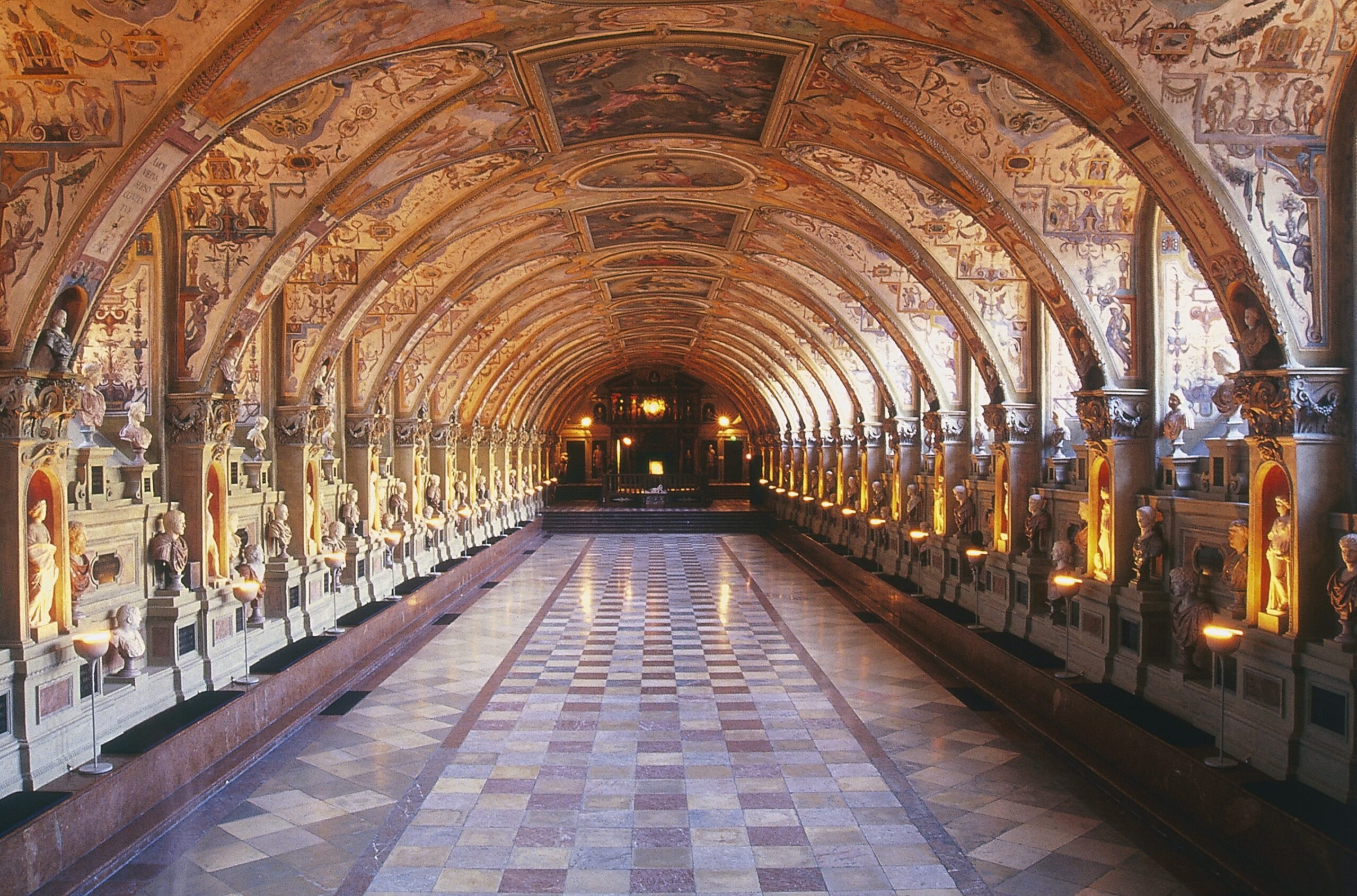
Nymphenburg Palace, a 17th-century summer retreat for the Wittelsbach monarchy, is a masterpiece of Baroque architecture. A guided tour takes you through rooms filled with frescoes, antique furnishings, and historical artifacts. Noteworthy sights include the Gallery of Beauties and the Hall of Mirrors. Allocate 3-4 hours to explore both the palace and its surrounding park, a harmonious blend of French and English garden styles with canals and sculptures.
For a relaxing interlude, visit Schlosscafe Palmenhaus, an erstwhile greenhouse now serving as a café and restaurant. It’s an ideal spot for “Kaffee und Kuchen”, a traditional German afternoon coffee and cake.
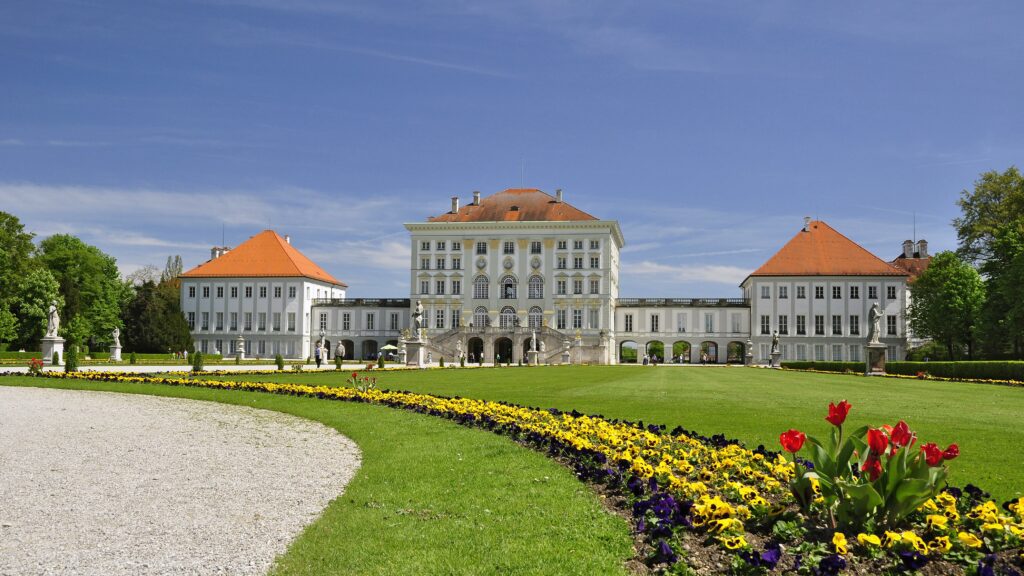
If art is on your agenda, the Kunstareal is a must-visit. Situated in central Munich, it encompasses 18 museums and art venues, over 40 galleries, six universities, and numerous cultural institutions. This area’s rich art heritage, earning Munich nicknames like ‘Athens on the Isar’ or ‘Florence on the Isar’, traces back to King Ludwig I’s passion for collecting art from Greece, Rome, and Florence.
Notable museums include Lenbachhaus, home to the world’s largest collection of Blue Rider movement art, featuring Kandinsky, Münter, and Marc. The State Museum of Egyptian Art, unique outside Egypt for its exclusive focus on Ancient Egyptian artifacts, and the Alte Pinakothek, with a vast array of European paintings from the 14th to 18th centuries, are other highlights.
Note: As of 2023, the Neue Pinakothek is closed for renovations until 2029.
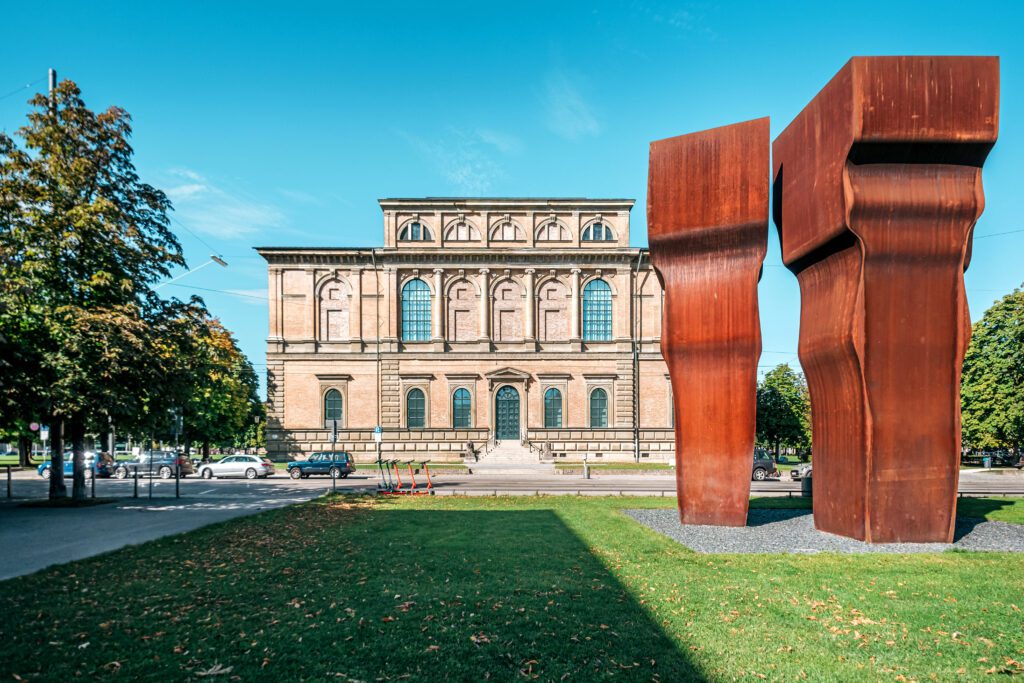
Day 4: Olympic History and the Legacy of Soccer & Cars
Munich’s Olympic Park, built for the 1972 Summer Olympics, has evolved into a top entertainment and event destination. And more than just a historical site, it’s a vibrant green space frequented by locals for jogging and walking. The park’s architecture and activities make it a compelling visit for travelers.
Climbing Olympic Hill, an artificial mound created from World War II rubble, offers panoramic views and is a popular spot for picnics and enjoying live music from the stadium.
Tip: On top of the hill, you’ll find Munich’s highest-situated beer garden, ‘Olympia Alm’.
Stroll along the shore of Olympic Lake and discover the Walk of Fame, where over 100 national and international figures have left handprints, signatures, and messages. For a leisurely exploration, pedicabs can take you through the scenic grounds, connecting various sports facilities.

The Olympic Stadium is a highlight, renowned for its half-moon-shaped canopy roof symbolizing transparency and light. Originally the stage for the 1972 Olympic ceremonies and competitions, it now hosts concerts and events.
Visitors can explore the stadium (except if events are taking place), and learn from exhibits like “Olympic Stadium 1972-2022”. This includes 22 steles detailing the park’s history, and the Filmkiosk72, where a 20-minute film recounts the Olympic Games. For an adventurous twist, a guided tour lets you walk on the stadium’s roof.
A memorial site for the 1972 Olympic attack was erected in 2017. A Pavilion houses a multimedia display commemorating the twelve victims of the Olympic massacre and outlines the contemporary historical background to the incident.

Note: The observation deck of the Olympic Tower offers a fantastic panoramic view, but be advised that the tower will be closed for approx. two years starting in June 2024.
Next to Olympic Park, you’ll find BMW World and Museum, must-visits for car aficionados. BMW World, a stunning glass and steel structure, showcases an array of models from all BMW Group brands. Visitors can explore independently or opt for a guided tour.
Next door, the BMW Museum, affectionately known as the “Weißwurstkessel” (sausage pot), offers a journey through BMW’s history. Its impressive collection of cars, motorbikes, and engines narrates the story of this century-old, iconic car brand.
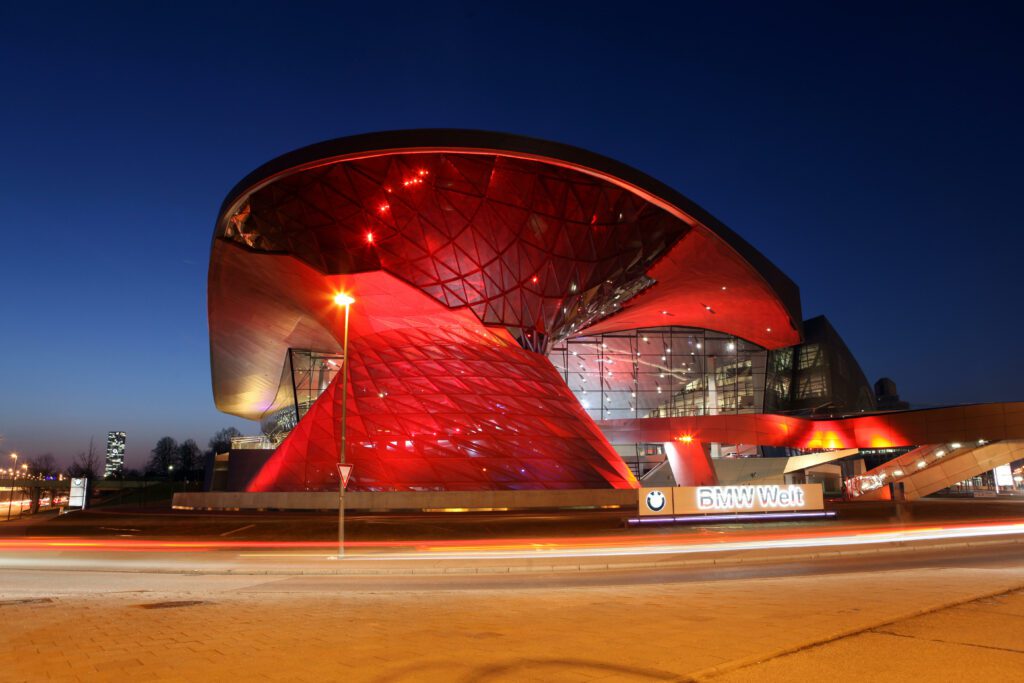
Allianz Arena, home of legendary soccer club FC Bayern Munich, is a must-do for any soccer fan. You can embark on a guided tour of the arena, immersing yourself in the electrifying atmosphere of game day: From a walk out of the tunnel, to an up-close view of the cabins and benches.
Adjacent to the arena, the museum offers a deep dive into the club’s storied 100-year history. Here, a Hall of Fame and various interactive stations bring the legacy of the soccer club to life.
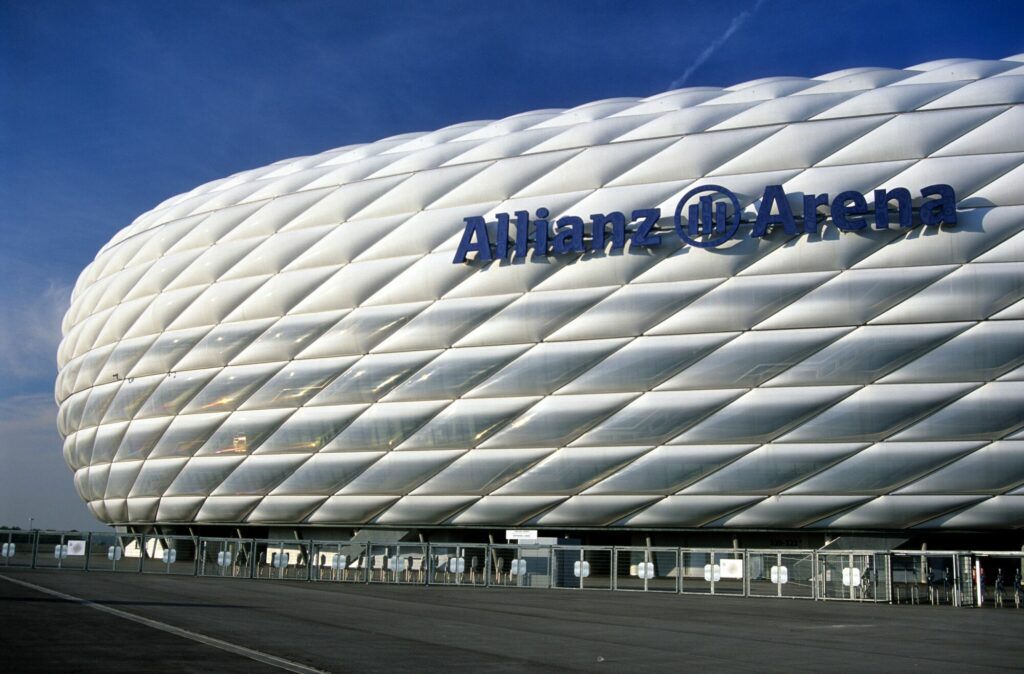
Day 5: Neuschwanstein Castle, Oberammergau, Linderhof Castle
Munich is an excellent starting point for a day trip to the enchanting Neuschwanstein Castle, the inspiration for Disney’s Sleeping Beauty Castle. Among Germany’s 20,000 castles, Neuschwanstein captivates the imagination like no other. Perched above Hohenschwangau near Füssen, it’s a celebrated landmark in southwest Bavaria.
King Ludwig II built Neuschwanstein as both a personal retreat and a tribute to composer Richard Wagner. Intended as a sanctuary, the reclusive king, however, never lived there.

While you can reach the castle via train or a two-hour car ride from Munich, I recommend a guided tour for ease of travel as well as a Skip-the-Line Service at the castle. This tour offered by the city of Munich, is particularly interesting since it also includes stops at Oberammergau, known for its painted houses, and a visit to Linderhof Palace. Linderhof, the ‘Royal Villa’, is the only castle finished in Ludwig II’s lifetime and is famed for its exquisite gardens.

Additional city explorations
Alternatively, if you opt to spend another day in Munich, consider these experiences: The Beer and Oktoberfest Museum is located in Munich’s oldest townhouse, dating back to 1340. The museum reopened in 2023 after a thorough renovation. It now offers interactive video installations. These bring the spirit of beer to life, immersing visitors in a festival tent atmosphere with music from the Wiesnkapelle and the cheer of party-goers. The experience concludes in the museum restaurant with a traditional stein of freshly tapped beer.
For a unique city sightseeing tour, hop on the tram or streetcar #19 #21 for a 20-minute ride. Starting at the central station towards “Berg am Laim,” you’ll pass landmarks like the Palace of Justice, Stachus, Lenbachplatz, and Promenadeplatz. The tram then leads to Max-Joseph-Platz, close to the Residence and the Opera, and on to Marienplatz and Odeonsplatz. The journey down Maximilianstraße offers celebrity-spotting opportunities and loops around the Maximilianeum, the Bavarian parliament. I suggest disembarking at Max-Weber-Platz and returning towards the central station.
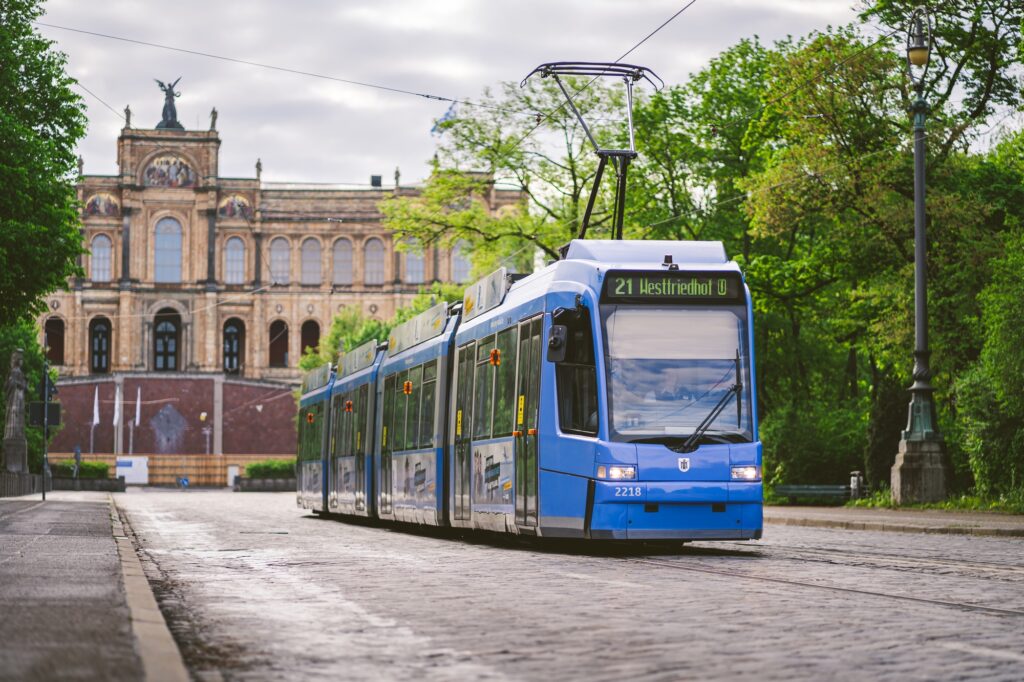
Getting around
Munich is a very walkable city, and all attractions are just a short ride away on the public transportation system. Following is a list of the four transportation systems in Munich:
1. ‘U-Bahn‘, short for ‘underground trains’; stations are marked by a white “U” on a blue background. 2. ‘S-Bahn’, short for suburban trains’ stations are marked by a white “S” on a green background. 3. ‘Trams’ or street cars. 4. Buses. Both, tram and bus stations, are marked by a green “H” inside a green circle on a yellow background.
You’ll mostly be using ‘U-Bahn’ and possibly the tram while in the city, but should you decide to visit Dachau Concentration Camp Memorial, you would use the S-Bahn. I recommend getting the Munich City Pass or the Munich Card. Both offer free transportation and discounts on the major attractions and are a great deal when staying in the city for five days.
To call Munich a ‘bike-friendly’ city would be an understatement. Many residents don’t own a car and instead opt to bicycle, and it’s safe to say that you’ll see more cyclists than cars in the inner city. Renting a bicycle is a great way to ‘do as the locals do’. There is an expansive net of bicycle lanes connecting the entire city, and bicycling is generally safe if you take common sense precautions and follow the rules. Watch out to not walk in a bike line when you are on foot – cyclists can get quite loud and even use their horns should you be in their way.
You don’t need a car in Munich, and in fact, it can be quite inconvenient. There are limited parking spots in the inner city, and the streets can be narrow and confusing to navigate. If you arrive by rental car, I would recommend leaving it in the hotel parking garage for any explorations within the city limits.

